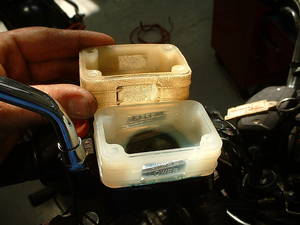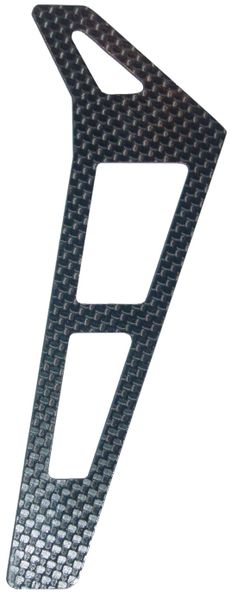Self-Sensing, Self-Healing Materials
Interview with
Helen - We're joined by Professor Frank Jones from Sheffield University who's developing materials which are capable of self-sensing and self-healing. Hi Frank.
Frank - Hi, Helen.
Helen - First of all, what do we mean by self-sensing and self-healing materials?
 Frank - Self-sensing is largely to do with the detection of damage immediately from the structure. Healing is the situation just like in the skin where any defects or cracks can repair themselves instantaneously. This can be done in many ways. Several attempts to do this: one is to incorporate little capsules of liquid monomer that can diffuse to the crack tip, once a crack runs, just like blood. Other techniques like the one we're trying to develop utilises the fact that a polymer has lots of unoccupied volume and other molecules that you can encase in the structure can diffuse through them to heal a crack when it forms. This is the general idea about these materials.
Frank - Self-sensing is largely to do with the detection of damage immediately from the structure. Healing is the situation just like in the skin where any defects or cracks can repair themselves instantaneously. This can be done in many ways. Several attempts to do this: one is to incorporate little capsules of liquid monomer that can diffuse to the crack tip, once a crack runs, just like blood. Other techniques like the one we're trying to develop utilises the fact that a polymer has lots of unoccupied volume and other molecules that you can encase in the structure can diffuse through them to heal a crack when it forms. This is the general idea about these materials.
Helen - First off, what sort of damage can they actually sense? What sort of materials can we try and heal?
Frank - We're mostly concerned with fibre-composite materials such as carbon fibre, reinforced resins and glass fibre reinforced resins. The nature of a composite failure is you get cracks in the matrix which are linked between the fibres. As long as the fibres are intact the structure's still quite healthy but the cracks could potentially be a weak link that could lead to total failure. What you need to do is to repair those few cracks that are in the resin and keep the structure intact over a long period of time.
Helen - I take it that these are very tiny, initially, very tiny cracks? They're very small?
Frank - Well it depends. They can spread across the whole material and just breach all the fibres and be effectively held together by the fibres that are present. If you walk along the road for example and look at the white lines by the side of the curb you'll find lots of multiple cracking in those white lines. Those white lines are cracked because of the various differences in the properties of the road surface, the tarmac and the white paint. You get the same phenomena in composites because you have the two stiffnesses between the two materials. Basically you've got a very similar analogous situation so you could realistically heal the white paint cracks as well.
Helen - You started to mention already, two different ways that we might go about making these self-healing materials. Can we talk more about that? How are we going to create these materials that know they've been damaged and do something about it?
 Frank - In the case that I'm working on we have carbon fibres which are electrically conducting. If you measure the resistance of carbon fibre you can have an easy method of detecting whether they're damaged or not. When fibre breaks the resistance will go up. We found that in an actual composite structure - if you've only got resin cracks there the resistance actually decreases. We can detect directly that there's a matrix around the fibres. Therefore we have the opportunity to utilise the resistance of the carbon fibres to provide a mechanism of healing. If you heat up the fibres using electrical resistance then you have a local heat where the energy needs to be created in order to heal the resin.
Frank - In the case that I'm working on we have carbon fibres which are electrically conducting. If you measure the resistance of carbon fibre you can have an easy method of detecting whether they're damaged or not. When fibre breaks the resistance will go up. We found that in an actual composite structure - if you've only got resin cracks there the resistance actually decreases. We can detect directly that there's a matrix around the fibres. Therefore we have the opportunity to utilise the resistance of the carbon fibres to provide a mechanism of healing. If you heat up the fibres using electrical resistance then you have a local heat where the energy needs to be created in order to heal the resin.
Helen - That would melt something that would then stick the material together, would it?
Frank - Yes you're right but it has to be a little bit more subtle than that. You don't want to lose the overall stiffness associated with the structure.
Helen - Are these materials as robust and tough as they were when we didn't have these systems in place to have them self-healing?
Frank - Fortunately composite materials can withstand a fair amount of damage before they actually fail. This is the reason why helicopter rotor blades are highly durable and last for millions of cycles in a fatigue experiment. Your other guest, Professor Phil Irving can tell you an awful lot about that since he's worked on fatigue in car springs. He was very much involved in the development of car springs for the automotive industry. They have a fatigue structure that will last the life of a motor vehicle. These materials are good but to ameliorate the damage it gives you an extra dimension to their life.
Helen - Am I right that these types of self-healing materials might have a use all that way out in space and that it's something that might help us out there?
Frank - I think that's a good idea. You could detect the damage remotely. You could send a signal to tell the material to heal itself so I'm sure there's a potential there.
- Previous MOF's and Molecular Sieves
- Next Self-Cleaning Glass










Comments
Add a comment